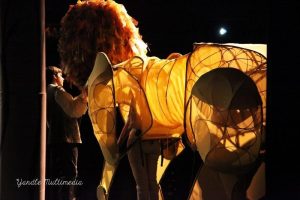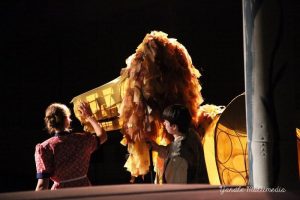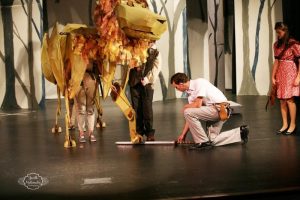Puppets in the Theater
For the 2014 production of The Lion, the Witch, and the Wardrobe, our director Bill Brent had the vision of creating an eight-foot puppet to bring life to the character Aslan the lion. The inspiration for this idea came from the play, The War Horse by Michael Morpurgo, adapted for the stage by Nick Stafford. The original War Horse production worked with the Handspring Puppet Company in South Africa to create a life size horse with three puppeteers controlling the horse’s entire being.
“I went and saw the War Horse when it came to Charlotte, and in the section next to us were a bunch of high schoolers who had clearly never been to the theater before. And in the story, set in world war I, the main character enlists in the war but part of his choice to enlist is he’s trying to find this horse. Then he’s blinded in a gas attack, so he’s in the camp and his horse has gotten tangled up in barb wire and so they bring the horse into the camp, they’ve got him out of the barbed wire. And the Sargent pulls out his pistol and points it at this puppet with two men inside of it and a kid to my right yells “No!!” People buy that that’s real. If you put that thing in a movie nobody would buy it. But in the theater, they gave it feelings and emotions, and that’s when I decided we could do a giant puppet. When I saw that people could buy it. People who weren’t even theater people, it’s easy for artsy people to buy artsy stuff. But when the teenager from Charlotte Meck buys that the horse is real and he says it out loud where all of us are saying the same thing inside, that’s when I started looking into it.”
– Bill Brent, Director
A s with any play, the research process began. Countless images, videos, materials, and other productions were considered when thinking about this massive task. Ideas turned into sketches, which turned into models, which turned into the great puppet. The cast spent only a summer learning to operate this massive puppet, all working together to make the lion come alive, from the puppeteers as well as the actors who interacted with Aslan. The hardest part for Mr. Bill was the engineering aspect of building a puppet, “Engineering was difficult. I’m not an engineer I’m a designer. So working through that was interesting.” The final product was made of two military backpack frames with the majority of the frame being shaped PVC. The mane of the lion was strips of organza hand sewed onto the head. “Soaked reed and corrugated plastic yard signs from the last election” were all included in puppet’s structure. Then the body of the puppet was covered in sports mesh, which enabled the puppet to be semi-transparent so you could see the frame and the actors. There were two actors/puppeteers inside the puppet, controlling the front and back legs and body. The actor who voiced Aslan also controlled the puppet’s head and mouth.
s with any play, the research process began. Countless images, videos, materials, and other productions were considered when thinking about this massive task. Ideas turned into sketches, which turned into models, which turned into the great puppet. The cast spent only a summer learning to operate this massive puppet, all working together to make the lion come alive, from the puppeteers as well as the actors who interacted with Aslan. The hardest part for Mr. Bill was the engineering aspect of building a puppet, “Engineering was difficult. I’m not an engineer I’m a designer. So working through that was interesting.” The final product was made of two military backpack frames with the majority of the frame being shaped PVC. The mane of the lion was strips of organza hand sewed onto the head. “Soaked reed and corrugated plastic yard signs from the last election” were all included in puppet’s structure. Then the body of the puppet was covered in sports mesh, which enabled the puppet to be semi-transparent so you could see the frame and the actors. There were two actors/puppeteers inside the puppet, controlling the front and back legs and body. The actor who voiced Aslan also controlled the puppet’s head and mouth.
“It wasn’t like we were trying to make it look like a real lion, but an imagination of what a lion could be” – Bill Brent, Director
“You were still an actor even though the audience couldn’t see your face. Coordinating the movements between both the back and the front silently was difficult. The group coordination that it took was a really interesting aspect to acting that you normally don’t get. It’s normally you by yourself but to make one single character come to life, three of us had to work so closely together to make it believable” – Sarah Brent, Puppeteer
 What a task to create an eight-foot puppet as the main character for a community theater play. So why a giant puppet? In The Lion, the Witch, and The Wardrobe, all of the animals talk including Aslan. Aslan is not simply an animal, but an important character who has feelings and thoughts. In the same way that you read an actors body language and facial expressions to capture their emotions, you had to do that with the great puppet as well.
What a task to create an eight-foot puppet as the main character for a community theater play. So why a giant puppet? In The Lion, the Witch, and The Wardrobe, all of the animals talk including Aslan. Aslan is not simply an animal, but an important character who has feelings and thoughts. In the same way that you read an actors body language and facial expressions to capture their emotions, you had to do that with the great puppet as well.
“Elliot’s voice (the actor who played Aslan) He found this voice for Aslan that’s not Elliot, he deepened it and gave it a fullness. And Elliot has a high view of reverence for God which came through in how he portrayed Aslan. There was a seriousness in how he approached portraying Aslan” – Bill Brent, Director
A slan had to be a presence on stage, he couldn’t have been a small character. A puppet can make an ordinary movement much more meaningful. A Puppet can stretch an audience member’s mind to places that it wouldn’t have gone with an actor. The puppeteers not only contributed through hours of coordination work, but also the other actors who interacted with Aslan all made this puppet come alive.
slan had to be a presence on stage, he couldn’t have been a small character. A puppet can make an ordinary movement much more meaningful. A Puppet can stretch an audience member’s mind to places that it wouldn’t have gone with an actor. The puppeteers not only contributed through hours of coordination work, but also the other actors who interacted with Aslan all made this puppet come alive.